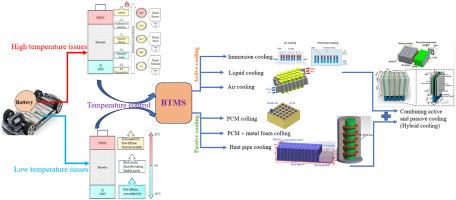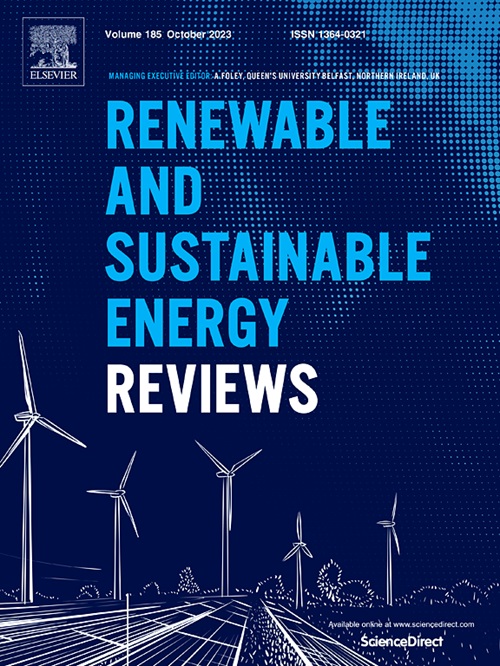电动汽车电池热管理的进展:混合 PCM-金属泡沫和浸入式冷却技术综述
IF 16.3
1区 工程技术
Q1 ENERGY & FUELS
引用次数: 0
摘要
电动汽车(EV)目前面临的主要挑战之一是对电池组进行有效的热管理,这对电池的性能和寿命都有很大影响。温度控制是确保高效电池热管理系统(BTMS)的关键参数,因此开发有效的实时散热技术至关重要。目前,大多数电动汽车采用间接液冷系统,该系统可有效降低电池温度,但受限于高泵功率要求和温度分布不均匀等问题,需要进一步研究和优化。本研究探讨了传统液体冷却和空气冷却方法的局限性,同时探索了与金属泡沫相结合的相变材料(PCM)的发展潜力,并将其与液体冷却结合起来,作为一种有前途的替代方法。此外,还全面回顾了混合冷却和浸入冷却系统的现状。还评估了运行策略和系统设计结构对性能和能耗的影响。值得注意的是,与基线设计相比,混合冷板设计的整体重量减轻了 53%,从而使耗电量降低了 90%。此外,本研究还探讨了 BTMS 对电动汽车电池生命周期成本、寿命和碳足迹的影响。研究结果表明,嵌入金属泡沫的 PCM 与液体冷却相结合,是快速充电和高能量密度电池的最佳选择。最后,还提出了未来研究的挑战和建议,以推动电池热管理系统领域的发展。本文章由计算机程序翻译,如有差异,请以英文原文为准。

Advances in battery thermal management for electric vehicles: A comprehensive review of hybrid PCM-metal foam and immersion cooling technologies
One of the major challenges currently facing electric vehicles (EVs) is the effective thermal management of their battery packs, which significantly impacts both battery performance and longevity. Temperature control is a critical parameter for ensuring efficient battery thermal management systems (BTMS), making the development of effective real-time heat dissipation technologies essential. Presently, most EVs utilize indirect liquid-cooling systems, which effectively reduce battery temperatures but are limited by issues such as high pumping power requirements and non-uniform temperature distribution, necessitating further research and optimization. This study examines the limitations of conventional liquid and air-cooling approaches while exploring the development potential of phase change materials (PCM) enhanced with metal foam, integrated with liquid-cooling as a promising alternative. Additionally, the current status of hybrid and immersion cooling systems is comprehensively reviewed. The effects of operational strategies and system design structures on performance and energy consumption are also evaluated. Notably, the hybrid cold plate design demonstrated a 53 % reduction in overall weight compared to the baseline design, which resulted in a 90 % decrease in power consumption. Furthermore, this study explores the impacts of BTMS on the life cycle cost, lifespan, and carbon footprint of EVs batteries. The results indicate that PCM embedded with metal foam, combined with liquid-cooling, is a highly suitable choice for fast-charging and high energy density batteries. Finally, challenges and recommendations for future research are presented to advance the field of battery thermal management systems.
求助全文
通过发布文献求助,成功后即可免费获取论文全文。
去求助
来源期刊

Renewable and Sustainable Energy Reviews
工程技术-能源与燃料
CiteScore
31.20
自引率
5.70%
发文量
1055
审稿时长
62 days
期刊介绍:
The mission of Renewable and Sustainable Energy Reviews is to disseminate the most compelling and pertinent critical insights in renewable and sustainable energy, fostering collaboration among the research community, private sector, and policy and decision makers. The journal aims to exchange challenges, solutions, innovative concepts, and technologies, contributing to sustainable development, the transition to a low-carbon future, and the attainment of emissions targets outlined by the United Nations Framework Convention on Climate Change.
Renewable and Sustainable Energy Reviews publishes a diverse range of content, including review papers, original research, case studies, and analyses of new technologies, all featuring a substantial review component such as critique, comparison, or analysis. Introducing a distinctive paper type, Expert Insights, the journal presents commissioned mini-reviews authored by field leaders, addressing topics of significant interest. Case studies undergo consideration only if they showcase the work's applicability to other regions or contribute valuable insights to the broader field of renewable and sustainable energy. Notably, a bibliographic or literature review lacking critical analysis is deemed unsuitable for publication.
 求助内容:
求助内容: 应助结果提醒方式:
应助结果提醒方式:


